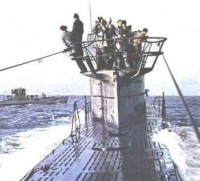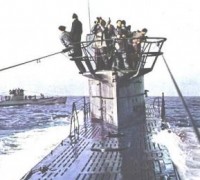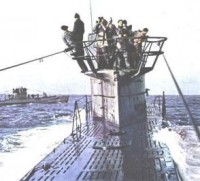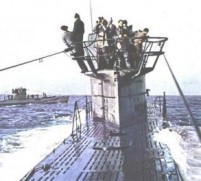U BOATS SUNK IN SOUTH ATLANTIC - U 128 / U 1062
39)U-662

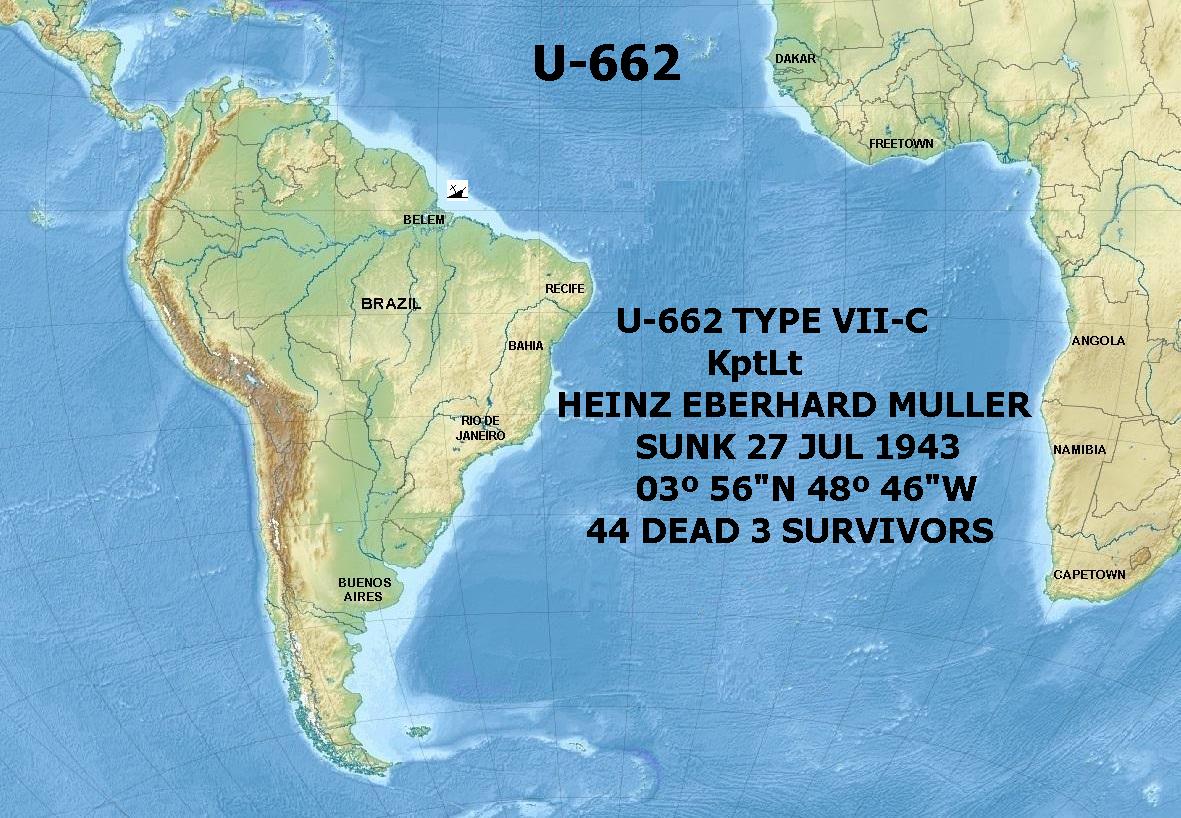
Ordered - 9 oct 1939
Laid down - 7 may 1941 Howaldtswerke Hamburg AG, Hamburg (werk 811)
Launched - 22 jan 1942
Commissioned - 9 Apr 1942 Kptlt. Wolfgang Hermann
Commanders - 9 Apr 1942 - 14 Feb 1943 Kptlt. Wolfgang Herman
10 Mar 1942 21 Jul 1943 Kptlt. Heinz-Eberhard Müller
Career
4 patrols 9 Apr 1942 - 30 Sep 1942 5. Flottille (training)
1 Oct 1942 - 21 Jul 1943 7. Flottille (active service)
Successes - 3 ships sunk, total tonnage 18,609 GRT
1 ship damaged, total tonnage 7,174 GRTFate: Sunk on 21 July 1943 in the Atlantic Ocean north of the Amazon estuary, in position 03.56N, 48.46W, by depth charges from a US Catalina aircraft (VP-94 USN/P-4). 44 dead and 3 survivors.
On 20 July 1943, 94-P-14 took off at 1030 Peter from Amapa, Brazil to relieve (4-P-8 covering convoy TJ-2. The plane made a sweep ahead of the convoy. On the return leg, at 1341 Peter, the bow lookout reported a ship to port, ten o'clock, five miles. The position was 03-33 North, 48-45 West. The plot, Lt.(jg) S.E. Auslander recognized it as an enemy submarine on course about 114 true. His altitude at the time was 4000 feet. He blew the warning horn and signaled the tower to put the mixture control into auto-rich.
The plane was nosed over and a turn to port started. Meanwhile, the co-pilot turned the bombing switch on and picked up the "pickle.". As the run was started, the air was filled with bursts of smoke and tracers. During the run, the navigator ran back to the blister for the camera and the radioman started to send out the contact report. The throttles were pulled back and the plane lost altitude and picked up speed as the pilot executed several skidding turns in order to evade the gunfire.
About a mile away from the sub, the pilot leveled off briefly and then pushed over again on course 240 true. The co-pilot, on signal from the first pilot made the drop at about 100 feet and 165 knots indicated. The pilot held his course briefly after pulling out, and then made a sharp turn to port. According to the navigator, who was in the starboard blister, the drop was over. The bombs landing 30 or 50 feet over the submarine on the starboard side and slightly ahead. The crew continued firing on the sub from blister guns and the bow gun. On scene of action voice frequency, the pilot called the escort vessels of the convoy which were close by, and at the same time the radioman was instructed to send MO's on 414 KCS.
The escort commander finally answered and was advised of the attack and position, and that the plane was sending MO's on frequency. Meanwhile the plane was still firing on the submarine, circling to port to give the port gun a chance to fire and then to starboard. The submarine continued to circle and return fire. After about 40 minutes, he started on an erratic zigzag course. At this time the plane had reached an altitude of 5000 feet, visibility was unlimited and there were no clouds.
The pilot felt that the escort would be able to see the plane at that altitude. A large wake, heading for the plane's position was observed, so course was changed toward the escort. He was approximately 20 miles away and making good speed. When the plane was half way between the sub and the escort vessel, the after-station reported the submarine starting to submerge. The pilot immediately turned and dove on it with a green fluorescent dye marker ready to mark the spot.
The U-boat seemed to have difficulty submerging, as it seemed to go under, come up, go under and come up again. It finally submerged at 1445 Peter and the marker was dropped. The plane, circling the spot, notified the escort vessels that the sub had submerged. The escort apparently discontinued his course towards the plane. The pilot started to fly a 20 mile square around the point at which the sub submerged and completed the circuit once.
At 1610 Peter the plane was relieved by 94 P-12, and after indicating the spot where the dye marker was still clearly visible, the plane departed for Belem. Although the crew thought the bombs fell over, pictures of the attack indicated a perfect straddle. The Plane expended all its ammunition strafing the submarine after the drop. In an hour time, the plane received but one hit by an explosive shrapnel shell even though it was within close gun range most of the time. The evaluation of this attack was "no damage."
Contributed by John B. Sargent
The following information has been obtained from German prisoners of war. The statements cannot always be verified; they should, therefore, not be accepted as facts unless they are definitely stated to be confirmed by information from other sources.U-662 carried a supply (stated by one P/W to be 100, by the other to be 30 or 40) of anti-radar balloons. These balloons are said to have a diameter of about 50 cm. when inflated. (One P/W said they were red, the other said they were silver grey.) Both agreed they were made of gutta-percha.
Around the center of the balloon runs a band of silvery wire mesh from which several wires hang down. A metal cylinder, stated to be made of tin or similar material, hangs a few feet below the balloon. The balloon is attached to a float by a light "silvery" wire (stated by one P/W to be 20 meters long and by the other to be 30 meters long).
It was stated that it is the cylinder and not the balloon which is intended as a Radar target and that the purpose of the balloon is soley to hold the cylinder (said to be approximately 15 cm. tall and 8 cm. diameter) were unknown to the P/W who stated that only the officers were familiar with them. Both P/W knew that these balloons are fitted with a self-destroying device, either in the float or the balloon or both, although neither of them knew exactly how it operated or just how much time elapsed before the device sank.
It was stated that, on at least one occasion, four balloons were released simultaneously immediately before an attack on a convoy, at night. The method was stated to have been to release the balloons, submerge to periscope depth, and later resurface some distance away to attack the convoy. Two steel cylinders containing hydrogen (about 1 m. high and about 20 cm. diameter) were mounted aft on the bridge, one on each side. The balloons were filled from these cylinders by a special attachment at the valve.
SECRET 31 AUG 1943
The following information has been obtained from a German prisoner of war. The statements cannot always be verified; they should, therefore, not be accepted as facts unless they are definitely stated to be confirmed by information from other sources: Further information has been obtained about the anti-radar balloons carried by German submarines. The balloons actually carried on patrol by U-662 were of red gutta-percha. The silver-grey type was not carried.
These balloons, as per attached sketch No. 1, were fitted with a small bottle shaped valve, through which the balloons were filled. This value was so fitted that once the balloon was filled, it produced a slow leak, giving off a low hissing sound. Instead of the "silvery" wire reported in Spot Item No. 126, the balloon was attached to the float by means of catgut, similar to a violin string, and instead of the metal container being suspended a few feet below the balloon it was suspended approximately 5 meters above the water.
At the bottom of the metal container was a hook from which several strips (prisoners believed there were 4 or more of these) of tinfoil were suspended. Another piece of catgut connected the containers with the float. Prisoners believed the float was fitted with a siluable plug so that it eventually filled with water and dragged the entire device down after a period of time, the length of which they did not know. The slow leak in the valve of the balloon also helped the sinking of the entire device.
Prisoners stated that the length of catgut from the container or cylinder to the balloon was 25 meters, and confirmed that the diameter of the balloon was approximately 50 cm. On 19 July 1943, a twin-motored aircraft was said by a prisoner to have attacked the U-boat. Four bombs were dropped without any damage. U-662 remained on the surface and returned fire, also without registering any hits. In the evening of the same day another slow-moving plane was driven off with gunfire before any attack could be made.
(O.N.I. Note: From available information it is not possible to identify these reported attacks.) On 20 July, the day before the sinking, a 4-motored plane succeeded in dropping four bombs ahead of U-662, but no damage was admitted. The U-boat in fact, claimed damaging hits on the port wing motor of the attacking plane, for smoke was seen pouring from this motor as the plane turned away. (O.N.I. Note: This would seem to be the prisoner's version of an attack on this date at 1345P, position 03 22N., 48 37W., reported by the pilot as follows: "Sub sighted, all bombs short - am circling and firing my guns."
In point of fact, no damage was inflicted on the plane. The belief that this attack caused any appreciable damage to the U-boat is certainly not borne out by any of the prisoners' statements.)Prisoners had seen balloons with a band of wire mesh around them, used experimentally, in port, at St. Nazaire. The use of these wire mesh band was, however, discontinued because they had to be placed on the balloon after it was inflated and fell off very quickly.
Two different experimental types have been seen, as illustrated in sketch No. 2 and sketch No. 2, the strips of tinfoil were above the cylinder, instead of below. The cylinder used was the same on all types. On patrol the balloons were inflated by the deck watch, but the cylinder and float were attached by the engineer officer personally. The cylinder was said to be about 25 cm. high and 8 cm. diameter. The float was somewhat larger. U-615 also carried 50 of the new type balloons when she was sunk off Amapa .
DATE AND TIME OF SINKING
The prisoner stated that the Catalina began the attack at 0645P or 1045 German time, 21 July, just 15 minutes before the U-boat was due to dive in accordance with an alleged standing order applicable to this area. (O.N.I. Note: The pilot's report gives the time of the attack as 0604, that is,41 minutes earlier than above.)
DEFENSIVE ACTION
As the plane approached from astern, all the anti-aircraft armament of the U-boat was brought to bear, but they were short of ammunition, and both 20-mm. guns soon jammed. Müller knew that the plane had been hit, however, and marveled at the nerve and steadiness of the pilot.
ACTION BY THE PLANE
The machine gun fire of the plane killed the entire bridge watch on the U-boat conning tower and one or two more on deck as well. One of the four depth-charges that were dropped hit the boat itself and two or three apparently exploded directly against the starboard saddle tanks. (O.N.I. Note: In reality, only three charges were dropped; one hung up. Had the planes .30 caliber bow gun been cleared, there probably would have been even less survivors from this sinking. The explosions around the U-boat, as seen from the plane, were more noticeable to port than to starboard.)
U 662 SINKS
There was an explosion in the control room, fuel oil caught fire, and water began to pour into the diving tanks, the conning tower, and the control room. According to a prisoner, the radio operator was barely able to dispatch an emergency message. The Commander was thrown into the water by the force of the explosion, receiving extensive injuries. The whole bow rose high in the air, the boat seemed to break in two and sank almost immediately, stern first. Of the five survivors left in the water, one died at once. The plane dropped two life rafts, which were promptly made use of by the commanding officer and the other three survivors.
SURVIVORS ADRIFT
During the next 16 days, the prisoner said, they were constantly followed by sharks. Once they put one life raft above the other and then made a hole in the top one in order to collect rain water. They also drank urine and sea water, but that only caused diarrhea and severe skin eruptions, which proved very difficult to treat. They had no food at all in the life rafts. A makeshift sail enabled then to make some headway, at times as much as three knots. Once they capsized, and it was only with great difficulty that they were able to right the raft again and pull themselves out of the water.
RESCUE OF SURVIVORS
The four survivors were picked up in the afternoon of 6 August 1943 by PC 494 at position 09º47"05'N 57º10"05'W. Later the prisoners were tranferred to yacht U.S.S. Siren. One of these, Seaman Second Willy Lübke died an hour later of multiple injuries and exposure on board the ship, ultimately leaving the wounded commander and two enlisted men as the only survivors.
U 662 sunk in her career 3 ships and damaged another. They were: Ville De Rouen, Ocean Viceroy, Empire Whale and Umaria. Ville de Rouen was sunk in the south Atlantic
By Capt. Jerry Mason USN Ret. www.uboatarchive.net
